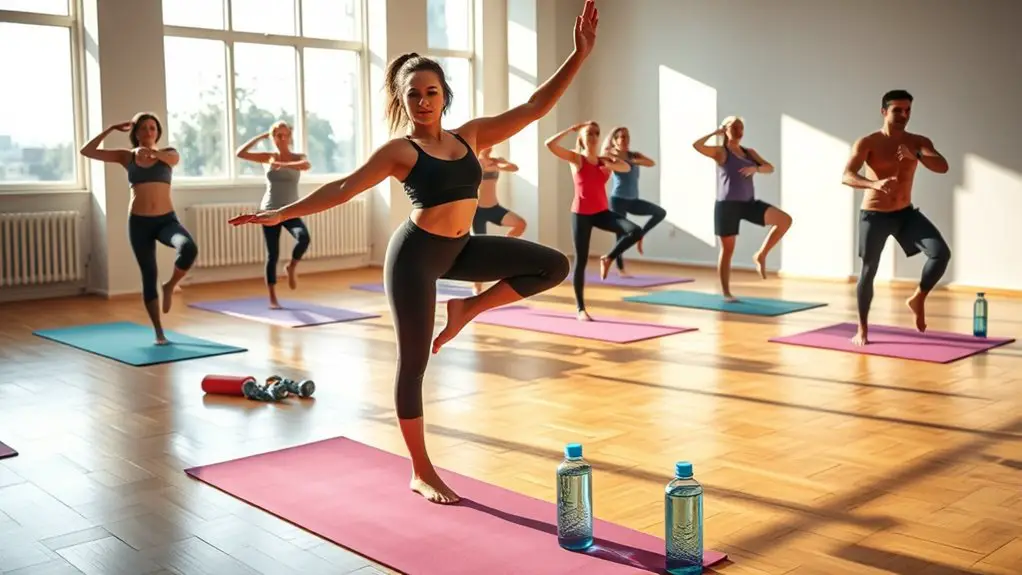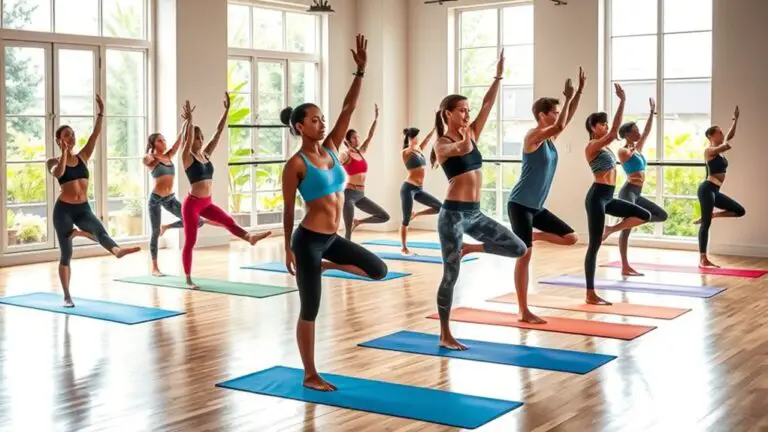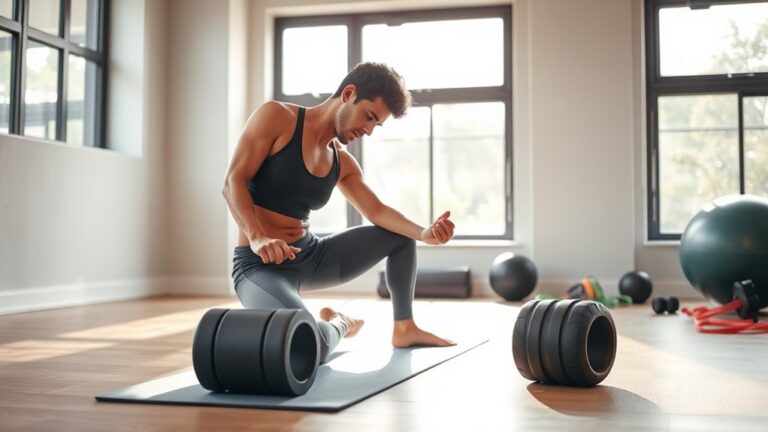Importance of Stretching Before & After Gym

Stretching before and after your gym sessions is essential for maximizing your performance and preventing injuries. Pre-workout dynamic stretches activate your muscles, improving flexibility and blood flow. Post-workout static stretching helps relax your muscles, aiding recovery while reducing soreness. Incorporating both types guarantees you stay limber and avoid injuries. Remember, the effectiveness of your routine can vary based on your workout type. Discover more ways to optimize your stretching regimen for the best results.
Benefits of Stretching for Athletes

When you stretch before and after workouts, you’re not just warming up or cooling down; you’re also enhancing your athletic performance. Stretching increases your flexibility, allowing your muscles to work more efficiently and reducing the risk of injury. When you incorporate stretching into your routine, you’re preparing your body for the demands of your sport, which can lead to better results.
Additionally, stretching plays an essential role in injury rehabilitation. It helps maintain range of motion and can alleviate tightness in muscles that often accompany injuries. By regularly stretching, you can support your recovery process, ensuring that you return to your peak performance safely and effectively.
Types of Stretching Techniques
When it comes to stretching, knowing the different techniques can really enhance your workout. You’ll want to explore static stretching for flexibility, dynamic stretching to warm up your muscles, and proprioceptive neuromuscular facilitation for improved range of motion. Each method offers unique benefits that can help you perform better and reduce injury risk.
Static Stretching Benefits
Static stretching offers numerous benefits that can enhance your overall workout experience. By focusing on static flexibility, you improve your range of motion and decrease the risk of injury. The static hold allows your muscles to relax, promoting recovery post-exercise.
| Benefit | Description |
|---|---|
| Improved Flexibility | Increases your muscle elasticity |
| Injury Prevention | Reduces muscle tension and soreness |
| Enhanced Performance | Prepares muscles for the workout ahead |
| Stress Relief | Promotes relaxation and mental well-being |
Incorporating static stretches into your routine can lead to lasting improvements. Just remember to hold each stretch for at least 15-30 seconds to maximize the benefits. Stay safe and enjoy the enhanced flexibility!
Dynamic Stretching Importance
Although many people focus on static stretching, dynamic stretching plays an important role in preparing your body for exercise. Incorporating dynamic warm-ups into your routine helps increase blood flow and enhances your overall mobility. These movements, like leg swings and arm circles, activate your muscles and joints, reducing the risk of injury during your workout.
Mobility drills are vital for improving your range of motion and flexibility, allowing you to perform exercises more effectively. By engaging in dynamic stretching before hitting the gym, you’ll not only boost your performance but also promote safety. So, don’t skip this important step—make dynamic stretching a part of your pre-workout routine to guarantee your body is ready for the challenges ahead.
Proprioceptive Neuromuscular Facilitation
Proprioceptive Neuromuscular Facilitation (PNF) is a highly effective stretching technique that can greatly enhance your flexibility and strength. This method involves a combination of stretching and contracting the targeted muscle group, utilizing proprioceptive techniques to improve your range of motion. By engaging in PNF, you can experience significant neuromuscular benefits, as it helps your muscles relax and lengthen more effectively.
To practice PNF safely, consider working with a partner who can assist you in applying gentle pressure during the stretch. Always focus on controlled movements and avoid pushing your limits too far. Incorporating PNF into your routine can lead to improved athletic performance while reducing the risk of injury, making it an excellent addition to your pre- and post-gym stretching regimen.
The Role of Stretching in Injury Prevention
When you incorporate stretching into your workout routine, you greatly enhance your body’s ability to prevent injuries. Understanding injury mechanisms helps you recognize how tight muscles can lead to strains. By stretching, you increase flexibility, which can counteract common stretching myths, like that stretching weakens muscles.
Here’s a quick breakdown of how stretching aids in injury prevention:
| Benefit | Explanation |
|---|---|
| Increases Flexibility | Looser muscles reduce strain during workouts. |
| Improves Range of Motion | Enhances movement efficiency and control. |
| Reduces Muscle Tension | Lowers the risk of sprains and tears. |
| Enhances Blood Circulation | Promotes healing and recovery. |
| Prepares Mind & Body | Fosters focus, helping to avoid accidents. |
How Stretching Enhances Performance

Stretching plays an essential role in enhancing your performance at the gym. It increases your flexibility and range of motion, which can lead to better workouts. Plus, it improves blood circulation, helping your muscles recover faster and reducing the risk of injury.
Increases Flexibility and Range
Incorporating stretching into your routine not only prepares your muscles for exercise but also greatly enhances flexibility and range of motion. You’ll experience significant flexibility benefits, allowing you to perform exercises more effectively and with less strain. This range improvement means your movements become smoother, helping you achieve better results in your workouts.
| Flexibility Benefits | Range Improvement |
|---|---|
| Improved muscle elasticity | Enhanced movement efficiency |
| Greater overall performance | Increased athletic ability |
| Better posture and alignment | More effective workouts |
Reduces Risk of Injury
Improved flexibility not only enhances your workout performance but also plays a significant role in reducing the risk of injury. When you stretch before and after your gym sessions, you’re actively engaging in injury prevention. This practice prepares your muscles and joints for the demands of exercise, making them less susceptible to muscle strain. Tight muscles are more likely to tear or become injured during physical activity, so incorporating a routine that emphasizes flexibility can help keep you safe. By taking the time to stretch, you’re not just warming up; you’re setting yourself up for a more effective workout and a smoother recovery. Prioritize stretching to protect yourself and enjoy a more sustainable fitness journey.
Enhances Blood Circulation
Flexibility exercises play an essential role in enhancing blood circulation, which directly impacts your workout performance. When you stretch, you’re helping to improve blood flow to your muscles, ensuring they get the oxygen and nutrients they need. This increased circulation not only prepares your body for intense activity but also aids in quicker recovery afterward. By incorporating stretching into your routine, you’ll experience significant circulation benefits, such as reduced muscle soreness and a lower risk of fatigue. Plus, improved blood flow can enhance your overall endurance, making it easier for you to push through your workouts safely. So, don’t skip those stretches; they’re crucial for keeping your body functioning at its best during and after your gym sessions!
Stretching and Muscle Recovery

While many people focus on lifting weights or cardio during their gym sessions, neglecting to stretch can hinder your muscle recovery. Incorporating stretching into your routine is one of the essential muscle recovery techniques you can adopt. It helps reduce muscle soreness and stiffness, allowing you to bounce back quicker for your next workout.
Post workout benefits of stretching include improved flexibility, which can enhance your overall performance and decrease injury risk. When you stretch after exercising, you encourage blood flow to the muscles, helping to remove lactic acid buildup and promoting healing. Plus, taking a few minutes to stretch can provide a calming effect that aids in mental recovery, too.
Guidelines for Effective Pre-Workout Stretching
Before you immerse yourself in your workout, it’s crucial to prioritize pre-workout stretching, as it sets the stage for a successful session. Incorporating effective warm-up techniques into your pre workout routine can enhance your performance and reduce the risk of injury. Start with dynamic stretches, like arm circles and leg swings, to get your blood flowing and muscles activated.
Focus on major muscle groups you’ll be using during your workout. Aim for 5-10 minutes of stretching, ensuring you maintain smooth, controlled movements. Avoid bouncing, as it can lead to strains. Instead, hold each stretch for about 15-30 seconds, allowing your muscles to adapt without overstretching.
Lastly, listen to your body. If something feels off or painful, modify your routine. By following these guidelines, you’ll create a solid foundation for your workout, helping you achieve your fitness goals safely and effectively.
Best Practices for Post-Workout Stretching
After you’ve completed your workout, taking time for post-workout stretching can greatly aid your recovery. Focus on gentle stretches that promote muscle relaxation and help alleviate tightness. Start with major muscle groups you worked during your session, holding each stretch for 15 to 30 seconds. Remember to breathe deeply; this not only enhances relaxation but also improves oxygen flow to your muscles.
Avoid bouncing or forcing any stretch, as this can lead to injury. Instead, aim for a slow and controlled approach. Incorporate stretches like the hamstring stretch, quadriceps stretch, and shoulder stretch, which can enhance flexibility and support overall post workout recovery.
Listening to your body is key; if something feels uncomfortable, ease off. Regular post-workout stretching can enhance your recovery process and help you maintain a safe and effective fitness routine.
Common Stretching Mistakes to Avoid
Stretching can be incredibly beneficial, but it’s easy to make mistakes that can hinder your progress or lead to injury. One common error is overstretching. Pushing your body beyond its limits can result in overstretching consequences, such as muscle strains or tears. It’s vital to listen to your body and know when to stop.
Another mistake is using improper technique. For instance, bouncing during a stretch can create tension rather than release it, increasing the risk of injury. Instead, aim for a slow, controlled motion.
Additionally, neglecting to warm up before stretching can also lead to problems. Stretching cold muscles isn’t effective and can be harmful. Always start with a light warm-up to prepare your body.
Incorporating Stretching Into Your Fitness Routine
When you’re looking to enhance your fitness routine, incorporating effective stretches is key to maximizing your results. You’ll want to take into account the types of stretches that suit your workout and when to perform them for ideal benefits. By timing your stretches right, you can improve flexibility and reduce the risk of injury.
Types of Effective Stretches
Incorporating effective stretches into your fitness routine can greatly enhance your performance and recovery. You’ll want to take into account static vs. dynamic stretches. Dynamic stretches, like leg swings and arm circles, warm up your muscles and improve flexibility before workouts. In contrast, static stretches, such as holding a hamstring stretch, are best for cooling down, helping to relax your muscles post-exercise.
Additionally, you can choose between active vs. passive stretching. Active stretching involves using your muscles to hold a position, promoting strength and flexibility, while passive stretching relies on an external force, like a partner or prop, to assist you. Both methods are effective, so mix them into your routine for ideal benefits and to enhance your overall safety and performance.
Timing for Optimal Benefits
Getting the timing right for your stretches can make a significant difference in your workout routine. To reap the timing benefits, aim to incorporate dynamic stretches before your workout to prepare your muscles. Spend about 5 to 10 minutes on these movements, warming up your body and enhancing performance. After your workout, focus on static stretches for ideal duration—holding each stretch for 15 to 30 seconds. This helps in muscle recovery and flexibility, reducing the risk of injury. Remember, a balanced approach to timing your stretches is essential. It not only improves your overall fitness but also guarantees that you stay safe while pushing your limits. Prioritizing these moments can lead to significant long-term benefits in your fitness journey.
Stretching for Different Types of Workouts
Although many people underestimate the role of stretching, it’s essential to tailor your routine based on the type of workout you’re doing. If you’re diving into resistance training, focus on dynamic stretches to warm up your muscles and improve your range of motion. These can include arm circles and leg swings, which help prevent injuries during lifting.
On the other hand, if you’re practicing yoga, incorporating deep yoga stretches is key for both pre- and post-workout. These stretches enhance flexibility and promote relaxation, helping your muscles recover effectively after intense sessions.
Don’t forget to cool down as well. After resistance training, static stretches can help alleviate muscle tightness, while after yoga, you might want to focus on gentle stretches to maintain that relaxed state. Prioritizing appropriate stretching for your workout type not only keeps you safe but also enhances your overall performance.
Frequently Asked Questions
Can Stretching Improve My Flexibility Over Time?
Yes, stretching can definitely improve your flexibility over time. By incorporating various stretching techniques into your routine, you’ll notice flexibility benefits that enhance your overall movement quality. It’s important to focus on gradual progress to avoid injury. Consistency is key; make stretching a regular part of your day. As you practice, you’ll find that your muscles become more pliable, allowing for a greater range of motion and improved physical performance.
How Long Should I Hold Each Stretch?
Imagine your muscles as rubber bands; the longer you hold a stretch, the more flexible they become. For dynamic stretches, just a few seconds is enough to warm up those muscles, while static stretches should be held for about 15 to 30 seconds. This way, you’ll enhance flexibility safely without pushing your limits too far. Remember, it’s all about listening to your body and easing into those stretches to avoid injury.
Is It Safe to Stretch With Injuries?
It’s essential to be cautious when stretching with injuries. While some gentle stretching techniques can aid in injury recovery, pushing too hard can worsen your condition. Always consult a healthcare professional before starting any stretching routine if you’re injured. They can guide you on which stretches are safe and beneficial for your recovery. Remember, it’s better to take it slow than to risk further injury. Your safety should always come first!
Should I Stretch Every Day for Best Results?
When it comes to stretching, you can’t have your cake and eat it too. Incorporating stretching into your daily routine can offer numerous benefits, like improved flexibility and reduced risk of injury. However, it’s crucial to listen to your body. If you feel pain or discomfort, it’s best to ease up. Aim for a balanced approach, blending stretching with rest days to guarantee safety while reaping those valuable stretching benefits.
Can I Stretch Without Going to the Gym?
Absolutely, you can stretch without going to the gym! In fact, incorporating stretching techniques into your home workouts can enhance flexibility and prevent injuries. You don’t need fancy equipment; just a quiet space will do. Focus on gentle stretches, ensuring you listen to your body and avoid pushing too hard. It’s a great way to relax and improve your range of motion, so go ahead and make it a part of your daily routine!





